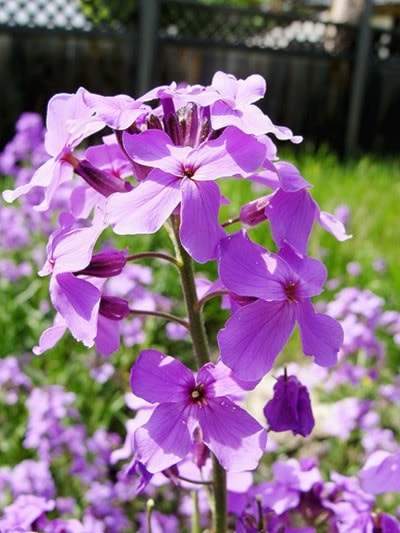Often sold in "wild flower" mixes, this pretty little invasive plant is escaping cultivation and
taking over woodlands and forest edges.
Dame’s Rocket is native to Eurasia and was brought to North America as a garden ornamental. This plant is also referred to as Dame’s Violet, Sweet Rocket and Mother-of-the-Evening.
Dame’s Rocket is often confused with Phlox, which looks similar but has five petals and some differences in the leaves as well.
Dame’s Rocket is a biennial or a short-lived perennial that develops as a rosette in its first year
and will flower in its second spring/summer. The leaves of a Dame’s Rocket plant can grow up
to 10 centimetres in length and 4cm in width and will have a lance-shaped appearance with
hairs on the top and the bottom, giving them a rough feel.
The flowers vary in colour and can be purple, pink as well as white, with the most common being purple and lavender. The flowers have four petals and are extremely fragrant; the fragrance becomes even more noticeable towards the evening. The more cultivated varieties can be mixed colours with double flowered forms.
Dame’s Rocket is an abundant seed producer and can produce up to 20,000 seeds per plant. It
wreaks havoc on the natural environment by out competing native plants and in turn threatens
the biodiversity in some areas. At the edges of woodlands, Dame’s Rocket will inhibit the
germination of tree seedlings, preventing further forest growth.
It is important to prevent further spread of this invasive plant, and to prevent its establishment
in the first place.
Be sure you know the names of the plants that are in any wild flower mixes that you are thinking of purchasing and ensuring that they are all native to your area. Once this plant has rooted itself in your area, it is important to care for it in a manner that is not going to cause further spread.
Smaller infestations can be manually pulled while large infestations should be clipped not pulled as this will disturb the soil and create prime growing area for any new germinated seeds.
Make sure to bag the plant material and any seeds in heavy plastic bags and take to designated
invasive plant bins at the Williams Lake, 100 Mile House or Quesnel landfills.
If you have any questions or concerns about Dame’s Rocket, or need assistance in identification or management, please contact the Cariboo Regional District’s Invasive Plant Management team toll-free at 1-800-665-1636, or visit our website at cariboord.ca.
